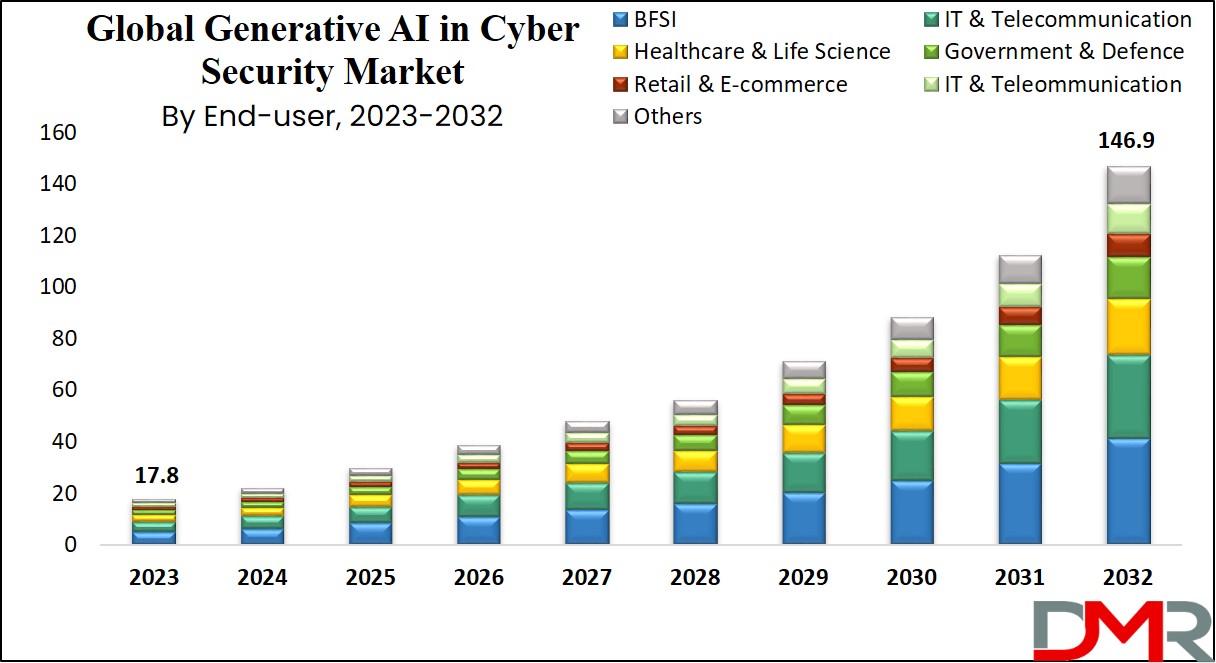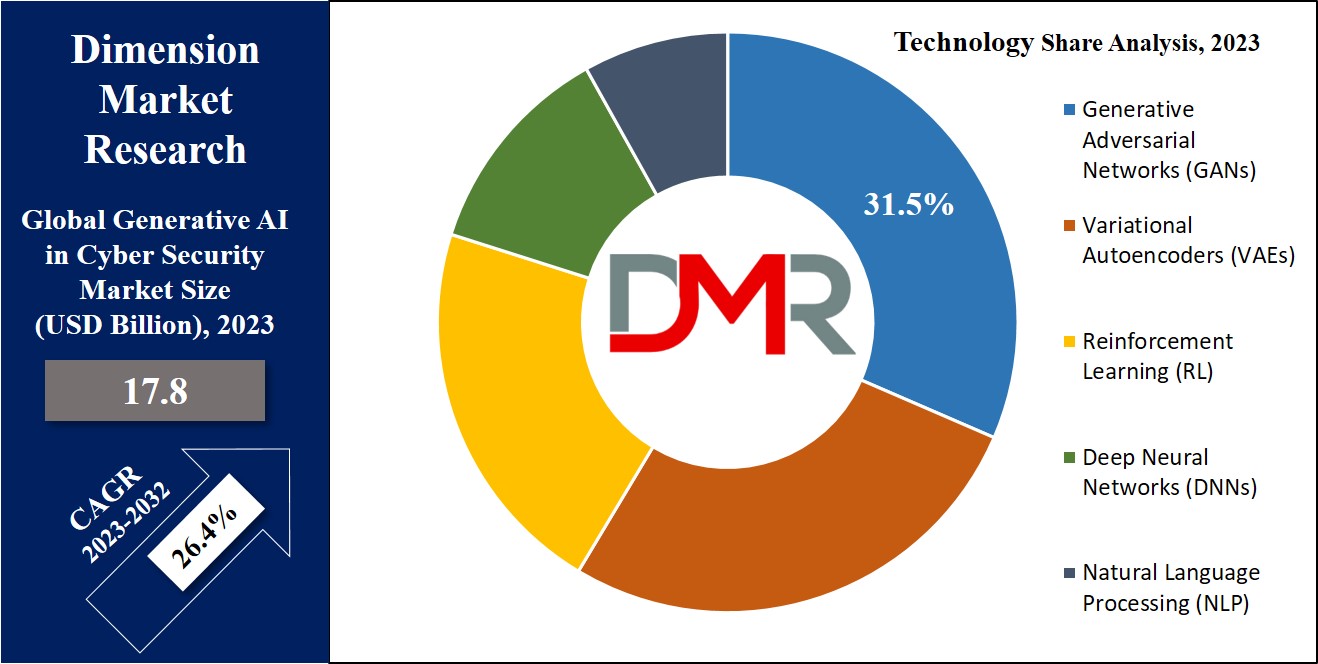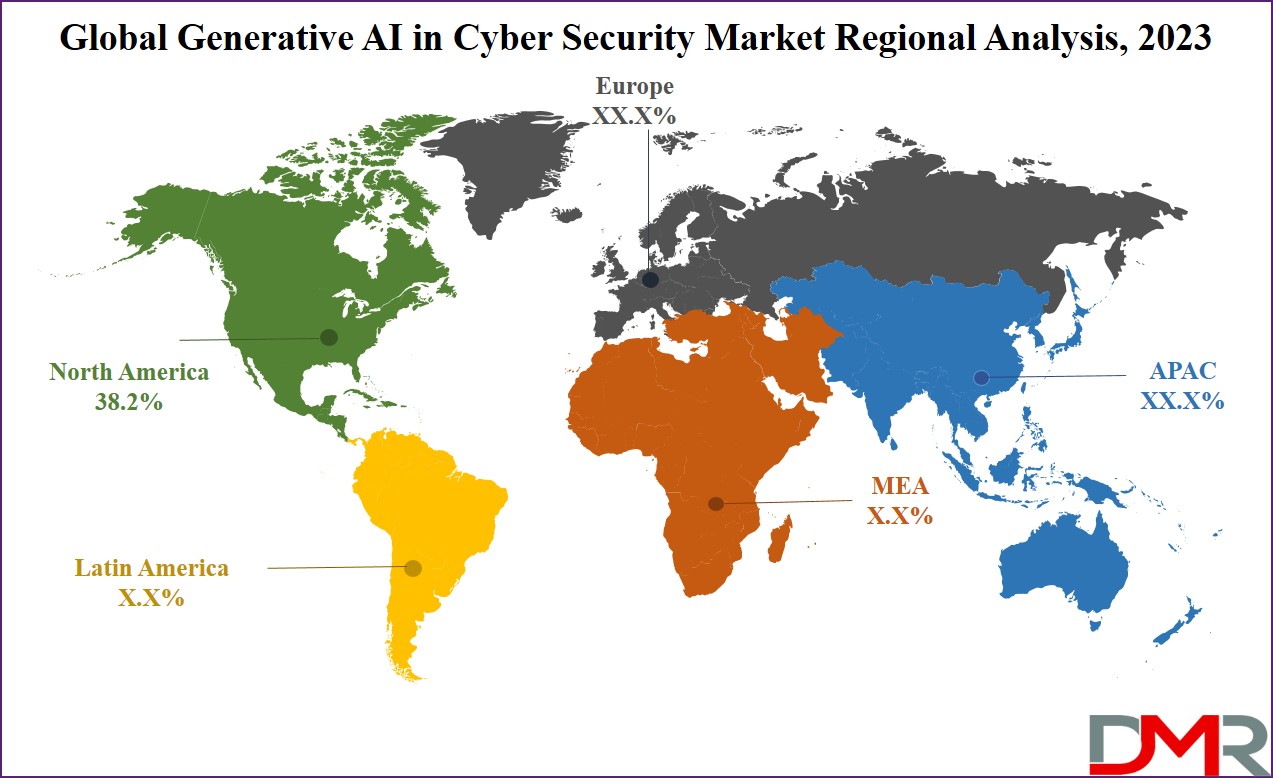
Generative AI in Cybersecurity refers to using generative
artificial intelligence models like GANs to improve the security system, threat detection, and response to malware and cyber-attacks. The generative AI stimulates Cybersecurity to evolve along with the increasing security threats. Generative AI improves cybersecurity by generating artificial data based on threats to train models to face and defend against cyber-attacks & enable a suitable response to security incidents.
Generative Artificial Intelligence works on various aspects of Cybersecurity involving data protection, threat detection, rapid response & security testing. The incorporation of generative Al in cybersecurity has improved its threat detection accuracy, quicker response time to cyber threats, reduced the possibility of false alarms & increased the ability to evolve attack techniques rapidly.
Key Takeaways
- The global Generative AI in Cybersecurity market was valued at USD 17.8 billion in 2023 and is projected to reach USD 146.9 billion by 2030, growing at a CAGR of 26.4%.
- The service segment in the market, offering consulting, training, and technical support, is expected to contribute significantly to market growth.
- The BFSI sector dominates the end-user market, utilizing generative AI to protect sensitive data and prevent fraud.
- North America held a 38.2% share of the global market in 2023, driven by its strong technological ecosystem and demand for advanced cybersecurity solutions.
- Key players in the market include IBM, CrowdStrike, Palo Alto Networks, Amazon Web Services, and Darktrace.
Market Dynamic
In the context of generative AI in the Cybersecurity market, several key dynamics are influencing its growth. Rapid advancements in AI & machine learning technologies are driving the growth of generative AI in the Cybersecurity market. This dynamic landscape is marked by the continuous development of effective self-learning AI-driven security solutions.
As Cybersecurity threats are becoming more advanced, organizations seeking advanced
generative AI solutions to fortify their defense are leading the market growth. Global events, budget constraints and the growing awareness about security threats among consumers & collaborations between cybersecurity companies & AI technology giants are also shaping the future of this market.
Research Scope and Analysis
By Type
Network security is a vital type of cybersecurity that is primarily concerned with the safeguarding of computer network systems & the data that is transmitted through them. In this system, if they detect data transmitted from an unknown source, data breaches and cyber-attacks. The network security services include a variety of elements like firewalls, intrusion detection systems, virtual private networks & user authentication, which enable the data protection levels.
In this network, firewalls are the first line of defense as they defend, monitor, and control the incoming & outgoing data traffic. They can be hardware or software-based and customized according to the use.
Network security is crucial in today's interconnected world as it helps to prevent data breaches, protect sensitive information & maintain the overall security system of the organization.
By Technology
In the technological segment, the generative adversarial network plays a major role in driving the domain of generative AI in cybersecurity. The generative adversarial network (GAN) is a class of machine learning models that are designed to generate data by learning from an already existing database.
This network consists of two neural networks, the generator & the discriminator, that are engaged in a continuous adversarial process. The generator's role is to artificially create a set of data that consists of images & characters, while the discriminator's task is to differentiate between the real database & the artificial database created by the generator.
In the context of cybersecurity, this network is used for several critical applications, such as generating artificial data to train security models to simulate cyber threats. These tests are essential for testing and strengthening the security system without exposing the real database.

By Component
Positioned as a major driver of market growth, the service segment in the generative AI in the cybersecurity sector which is set to hold a substantial portion of the market in the upcoming years. Services in this market have various modes of application like consulting, training, technical support & management services provided by the Cybersecurity firm. The demand for service is anticipated to make a notable contribution to the global generative AI in the Cybersecurity market.
The service providers are now shifting their focus on offering new components to the AI, like
machine learning algorithms, sensor data analysis, computer vision & speech recognition. This application or feature enhances the capabilities of the Generative AI to tackle the new Cybersecurity threats.
By End-User
The end-user segment is dominated by the banking, financial services, and insurance sectors as they distinctly stand out, commanding a substantial 28% of the market share in 2023. This segment is popular because it uses generative AI-integrated Cybersecurity programs extensively to combat and avoid data fraud, enhance risk protection & fortify the protection system of customer data. banking, financial services, and insurance sectors.
Further, the government & defense sector have also embraced the idea of using generative AI to boost their Cybersecurity alert, safeguard critical infrastructure information, detect advanced threats and breache,s and most importantly, reinforce national security. The capability to access an extensive database & real-time network traffic monitoring helps the generative AI to identify & counter the major Cybersecurity threats.
The Global Generative AI in Cybersecurity Market Report is segmented based on the following:
By Type
- Network security
- End-Point Security
- Application Security
- Cloud Security
By Technology
- Generative Adversarial Networks (GANs)
- Variational Auto-encoders (VAEs)
- Reinforced Learning (RL)
- Deep Neural Networks (DNNs)
- Natural Language Processing (NLP)
By Component
- Hardware
- Software
- Services
By End-user
- Banking, Financial Services, and Insurance (BFSI)
- IT & Telecommunication
- Healthcare and Life Science
- Government and Defense
- Retail and E-commerce
- IT and Telecommunication
- Others
Regional Analysis
In 2023, North America emerged as the dominant revenue generator in the global generative AI in Cybersecurity market as it a substantial market
share of 38.2%. This region's dominance can be attributed to its expanding technological ecosystem, where major industries like finance, healthcare, and government are significantly mining with increasing Cybersecurity threats.
This region constantly invests in new innovative cybersecurity ideas & cutting-edge technologies to counter the increasing cybersecurity threat. Sectors like finance and healthcare are now relying on advanced security measures to protect sensitive data, making generative AI an indispensable tool in Cybersecurity systems. So, combining these factors shows that North America plays a pivotal role in the growth of Global generative AI in the security market.

By Region
North America
Europe
- Germany
- The U.K.
- France
- Italy
- Russia
- Spain
- Benelux
- Nordic
- Rest of Europe
Asia-Pacific
- China
- Japan
- South Korea
- India
- ANZ
- ASEAN
- Rest of Asia-Pacific
Latin America
- Brazil
- Mexico
- Argentina
- Colombia
- Rest of Latin America
Middle East & Africa
- Saudi Arabia
- UAE
- South Africa
- Israel
- Egypt
- Rest of MEA
Competitive Landscape
The Global Generative AI in Cybersecurity is witnessing a dynamic transformation as both major companies who have established their name in the market and newcomers are using all their resources to fortify their positions. this shift can be attributed to the increased investments in new cutting-edge technologies such as machine learning, neural networks & natural image processing. These investments push the companies to enhance their Al-driven cybersecurity defenses to stay ahead in this cutting-edge competition.
As the major industry giants have recognized the role of Artificial intelligence in the further development of Cybersecurity , they are directing their investments in different ways to keep their position ahead. They use organic and inorganic growth strategies where organic includes internal research and development to get an accurate and error-free generative Al in Cybersecurity while the inorganic strategies encompass mergers, acquisitions and collaborations with other companies to jointly develop or work on some project.
Some of the prominent players in the Global Generative AI in Cybersecurity Market are:
- IBM Corporation
- CrowdStrike
- Palo Alto Networks
- Acalvio Technologies Inc.
- Amazon Web Services Inc.
- Cylance Inc. (Blackberry)
- Darktrace
- FireEye Inc.
- Fortinet Inc.
- Intel Corporation
- LexisNexis
- Micron Technology Inc.
- Other Key Players
Recent Developments
- In May 2025, Ekinops, a global network solutions provider, announced the acquisition of Olfeo, a cybersecurity software provider, to enhance its portfolio and strengthen its presence in the cybersecurity market for businesses.
- In July 2025, Deep Algorithm, a cybersecurity startup, successfully raised Rs 10.8 crore from Unicorn India Ventures to further develop its innovative cybersecurity solutions and expand its operations across key markets.
- In May 2025, Cloudsek, a cybersecurity startup specializing in AI-driven threat intelligence, secured $19 million in funding to accelerate the development of its platform and expand its market footprint globally.
- In August 2025, the Cybersecurity and Infrastructure Security Agency (CISA) and FEMA announced a joint initiative with a $100 million grant to enhance cybersecurity resilience across critical infrastructure sectors in the U.S.
Report Details
| Report Characteristics |
| Market Size (2023) |
USD 17.8 Bn |
| Forecast Value (2032) |
USD 146.9 Bn |
| CAGR (2023-2032) |
26.4% |
| Historical Data |
2017 - 2022 |
| Forecast Data |
2023 - 2032 |
| Base Year |
2022 |
| Estimate Year |
2023 |
| Report Coverage |
Market Revenue Estimation, Market Dynamics, Competitive Landscape, Growth Factors and etc. |
| Segments Covered |
By Type (Network Security, End-Point Security, Application Security and Cloud Security), By Technology (Generative Adversarial Networks, Variational Auto-encoders, Reinforced Learning, Deep Neural Networks and Natural Language Processing), By Component (Hardware, Software and Services), By End-user (Banking, Financial Services and Insurance, IT & Telecommunication, Healthcare and Life Science, Government & Defense, Retail and E-commerce IT and Telecommunication and Others) |
| Regional Coverage |
North America – The US and Canada; Europe – Germany, The UK, France, Russia, Spain, Italy, Benelux, Nordic, & Rest of Europe; Asia- Pacific– China, Japan, South Korea, India, ANZ, ASEAN, Rest of APAC; Latin America – Brazil, Mexico, Argentina, Colombia, Rest of Latin America; Middle East & Africa – Saudi Arabia, UAE, South Africa, Turkey, Egypt, Israel, & Rest of MEA |
| Prominent Players |
IBM Corporation, CrowdStrike, Palo Alto Networks, Acalvio Technologies Inc., Amazon Web Services Inc., Cylance Inc.(Blackberry), Darktrace, FireEye Inc., Fortinet Inc., Intel Corporation, LexisNexis, Micron Technology Inc., and Other Key Players |
| Purchase Options |
We have three licenses to opt for: Single User License (Limited to 1 user), Multi-User License (Up to 5 Users), and Corporate Use License (Unlimited User) along with free report customization equivalent to 0 analyst working days, 3 analysts working days and 5 analysts working days respectively. |